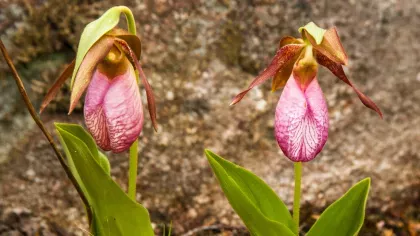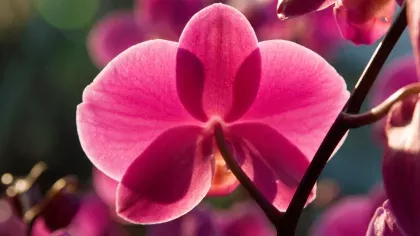31 August 2018
The secret sex life of anthropomorphic orchids
‘Orchid Hunter’ and PhD student Leif Bersweden describes the genetic mix-and-match life of human like orchids.

The word ‘orchid’ commonly conjures up images of exotic, extravagant blooms in far-flung corners of the rainforest – or perhaps the gaudy display welcoming you into your local supermarket.
Rarely, if ever, would you imagine plants with human-like flowers growing in fields surrounding a quaint English village, or high up in the French mountains. Yet such plants exist.
Their names seem fanciful: man, monkey, lady and military orchids.
But a glance at these charismatic plants quickly reveals why they are so aptly named: their petals resemble little people – they have arms and legs – and as such they are referred to as being anthropomorphic.
It might sound like something out of a fairy tale, but there is more to these innocent-looking plants than meets the eye.
At first glance they look very different from one another.
The main petal, or lip, of the man orchid (Orchis anthropophora) takes the shape of a whimsical yellow figure whose limbs are often tinged chocolate brown or burgundy.
Lady orchids (O. purpurea) have flowers that supposedly resemble a frilly white dress beneath a bonnet of deep red petals and sepals. It doesn’t take long to find the monkey in the monkey orchid (O. simia), whose lip is white with very fine purple appendages.
Nor does it require much imagination to see its long tail. And lastly, the military orchid (O. militaris) sports broad pink limbs, purple trench coat buttons and a pale grey helmet.
They are all different. So different, in fact, that anyone could sit down with a very simple botanical key and be able to identify them all.


Hybrids and gene flow
However, when these orchids grow together, they can’t keep their hands off each other.
Unlike most species, they don’t pay any attention to rules about who’s allowed to breed with whom; instead, they happily engage in a bit of light-hearted, inter-species pollination when the opportunity presents itself.
These partnerships result in intermediate offspring called hybrids that half resemble one parental orchid species and half the other.
It’s as if you’ve merged the two species, and the resulting plant has characteristics of both parents: the shape of a man orchid with the colouration of a monkey orchid, for example.
Where hybridization events such as this occur, it often leads to the build-up of large hybrid orchid populations.
Some hybrids appear to be sterile, while preliminary data suggests others are able to reproduce with each other and with their parents.
Very simply, you can imagine it like this: the two parent species are at either end of the spectrum and the hybrids occupy the space in between, forming a range of intermediates.
Some hybrids appear perfectly intermediate, while others look more like parent A or B. If the hybrids are fertile and able to reproduce with the parent species genes will be able to move from one parent to the other, via the hybrid, in a process called introgressive hybridization.

How can genes move between species?
Introgressive hybridization sounds like a scary and complicated process but the concept is very straightforward.
Imagine a hybrid between a lady and a military orchid. In simple terms, half of its DNA is that of a lady and half is that of a military. Imagine, then, that this hybrid is fertile and reproduces with a lady orchid.
The DNA of the resulting offspring, again in very simple terms, would be 75% lady and 25% military.
If this plant then reproduces with another lady orchid, the proportion of military orchid DNA would be diluted further.
If this continues then you would eventually end up with plants that look like lady orchids and are genetically 99% lady orchid, but with a little bit of military orchid DNA.
In this way genes can move from one species to another via this repetitive reproduction with a fertile hybrid.

Why aren’t all species able to reproduce with each other?
The maintenance of individual plant species is largely a result of a series of reproductive barriers that together ensure different species are unable to successfully produce fertile offspring.
Some barriers act before pollination occurs. For example, one species might flower earlier in the year than another, or employ a different pollinator species.
These are simple ways to ensure your pollen reaches plants of the same species, rather than close relatives. Other barriers occur further down the line, acting as a post-pollination safety net.
These might include the production of inviable seeds or sterilization of the hybrid, both of which prevent continuation of the line.
All four anthropomorphic orchids flower (more or less) simultaneously and are pollinated by generalist pollinators like bumblebees, increasing the likelihood of pollen transfer from one species to another.
This suggests that the mechanism preventing them from merging is probably not one that acts before pollination.
And this makes sense, given the frequency with which hybrids are observed.
How do these orchids maintain their four separate identities?
So here lies our unanswered question.
There are four anthropomorphic orchids, all of which look very different.
And yet, despite reproducing with each other and swapping genes and DNA sequences between them, they have maintained their four separate identities. Why haven’t they merged into one big hybrid super-species?
There are numerous hypotheses. It could be because the hybrid is less suited to the environments in which they grow, preventing them from out-competing their parents.
It might be because pollinators rarely visit the hybrids, impeding the transfer of hybrid pollen to the parental plants.
Or perhaps certain key genes are unable to move between species. But the real answer is we just don’t know yet.
For now, the reasons for their integrity remain a mystery, though hopefully not for long.
Our research at Kew will help improve our understanding of hybridization which will have benefits for the conservation of these orchids, both here in Britain and across Europe.
There is so much waiting to be discovered, but we do know that this group of innocent-looking species actually lead a life of sexual immorality and genetic mix-and-match.
So, befitting of a fairy tale, these orchids aren’t quite what they might seem.
Related links
Leif's book 'The Orchid Hunter' is available in the Kew Shop



